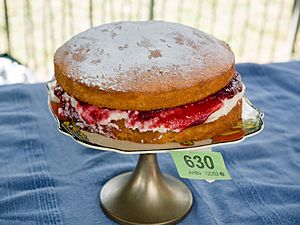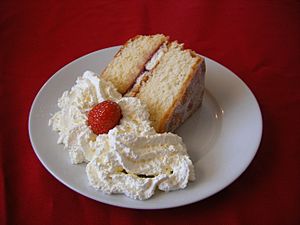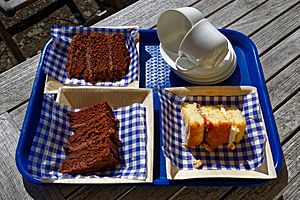Sponge cake facts for kids
|
A yummy Victoria sponge cake at a baking competition in 2014
|
|
| Type | Cake |
|---|---|
| Region or state | Europe |
| Main ingredients | Flour, sugar, eggs |
Sponge cake is a light and airy cake made from flour (usually wheat flour), sugar, and eggs. It's called "sponge" because its texture is soft and full of tiny holes, just like a sponge!
Some people believe that sponge cake was one of the very first cakes made without yeast. This means it didn't need yeast to rise, making it different from many older bread-like cakes.
Contents
Different Kinds of Sponge Cakes
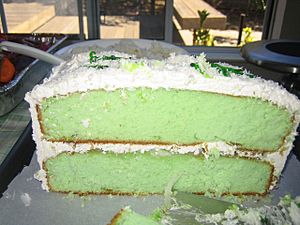
There are many delicious types of sponge cakes around the world, each with its own special twist!
Asian Sponge Cakes
In Asia, you'll find many unique sponge cakes.
- The ma lai gao is a steamed sponge cake popular in Malaysia.
- Chinese almond sponge cake is also steamed and often topped with yummy things like chocolate, fruit, or even vegetables!
- Korean sponge cake, called saeng, is usually made with rice flour and topped with whipped cream and fresh fruit.
- Vietnamese versions sometimes add fresh herbs like mint or lemongrass to the batter. They often use caramelized tropical fruits as a topping.
- In India, milk and a special sugar called jaggery are added. It's often served with a creamy Sri Lankan treat called avocado crazy.
- Western-style sponge cakes with whipped cream and strawberries are super popular in Japan. Sponge cake is also used as the base for many cheesecakes there.
Angel Food Cake
Angel food cake is a classic American cake from the 1800s. What makes it special? It doesn't use any egg yolks or butter! It gets its light, fluffy texture from whipped egg whites and baking powder. This delicate cake is baked in a special pan and cooled upside down.
Chiffon Cake
Chiffon cake is another light and moist cake. It's made with vegetable oil, which helps keep it soft. It's a bit like angel food cake and was a popular dessert in Hollywood during the 1930s, often served with grapefruit.
Boston Cream Pie
The Boston cream pie is the official dessert of Massachusetts! It's a delicious layered yellow sponge cake. It has a creamy pastry cream filling and is topped with a chocolate glaze. It might have come from a cake called the Washington Pie, which was two layers of yellow sponge cake with jam.
Tipsy Cake
Isabella Beeton, a famous cookbook author, had a recipe for Tipsy Cake in her book. This cake was baked in a fancy mold, then soaked in sherry and brandy. It was often served with custard poured over it, or broken into pieces like a trifle and topped with whipped cream.
Trifle
The earliest trifle was a simple thickened cream with sugar and rosewater. Later, recipes added egg-thickened custard poured over sponge fingers and almond cookies soaked in wine. In 1747, a recipe added a frothy dessert called syllabub and currant jelly. Today, trifle is a layered dessert with sponge cake, fruit, custard, and cream.
Victoria Sponge Cake
The Victoria sponge, also known as the Victoria sandwich cake, was named after Queen Victoria. She loved to enjoy these small sponge cakes with her afternoon tea.
The Victoria sponge cake developed from the classic pound cake. Pound cakes traditionally used equal amounts of butter, sugar, eggs, and flour. Some experts say calling the Victoria sandwich cake a "sponge" is not quite right, but the name stuck!
The big difference that made the Victoria sponge so popular was the invention of baking powder in 1843 by Alfred Bird. This amazing invention helped the cake rise much higher and become even lighter. This new cake was seen as a patriotic symbol in Britain.
A typical Victoria sponge is filled with strawberry jam. Modern versions often add cream too, but Queen Victoria's cake would have had only jam. Two sponge cakes are sandwiched together, and the top is usually just dusted with caster sugar or icing sugar, without any other frosting.
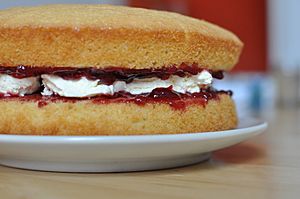
You can make a Victoria sponge in two main ways:
- Traditional method: You cream (mix until fluffy) the sugar and butter first. Then you slowly add beaten eggs, and finally fold in the flour and baking powder.
- Modern method: Using an electric mixer or food processor, you simply whisk all the ingredients together until they are creamy. This method often uses a bit more baking powder and softer butter.
Both methods are quite quick and easy, which makes this cake popular for kids to bake and for people who are in a hurry. This basic cake mixture is used to make many other treats, like cupcakes, chocolate cake, and Eve's pudding.
Even though they are simple, Victoria sponge recipes are very sensitive to cooking times and temperatures. Because of this, oven makers often use a Victoria sponge recipe to test how well their ovens work! Baking the perfect Victoria sponge is also a classic challenge at British village fairs.
Related pages
Images for kids
-
Pandan cake is a sponge cake from Southeast Asia. The way it's made came to Asia through European trade or colonization.
-
Tres leches cake is a sponge cake soaked in three kinds of milk: evaporated milk, condensed milk, and heavy cream.
-
Homemade Battenberg cake covered in marzipan and, when cut, shows a cool pink and yellow checkerboard pattern.
See also
 In Spanish: Bizcocho para niños
In Spanish: Bizcocho para niños


